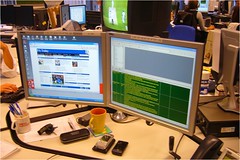When I looked into the music store room next to one of the computer labs in my new school, I didn't see a music store room. I saw a teachers' computer lab. The size and shape -- long and narrow -- were irrelevant. I knew I could make better use of it than how it was being used now. It was not so much a store room as a junk room, with old music stands scattered all over the place, piles of paper which had obviously not been looked at in ages, judging by the dust on them. So I went to the headteacher, and asked if I could have the room. To my delight (and, I have to say, surprise) he said "Yes."
Before going any further I should point out that this was some time ago, before many teachers had computers at home, or schools had laptops. However, I think my comments will still be relevant today. In my view, teachers need areas where they can prepare materials, search the web or mark online without being distracted by the general hubbub of the staffroom.
I wanted an area where teachers could just come, use the facilities whenever they liked, and without needing to ask permission. I often had teachers come to my classroom to ask if there was a spare computer they could use. I always welcomed them, but I felt that teachers also needed privacy in relation to students.
I cleaned and tidied up the room, and installed 8 computers, a printer and a scanner. The question arose, should I furnish the room with equipment I'd replaced, ie older stuff? My answer (to myself) was "No." Teachers should have the latest and, funds permitting, the best. Why?
First, I think teachers deserve the best. Simple as that.
Secondly, there was a mercenary element to my thinking, which ran as follows. If a teacher is using really good, fast equipment that is not past its use-by date, not scratched from years of use, not unreliable, they will probably be much more likely to consider booking the computer facilities for use with a class.
My gamble paid off. The room was in constant use, and not always by the same people. I think nearly everyone on the staff list used it fairly regularly. It was a very good use of a space that wasn't being used effectively at all.
What might be different today, now that laptops and tablets are to be seen almost everywhere?
First, I would still have a room like that. Teachers still need a place they can work, away from the probing eyes of pupils.
Secondly, if the powers-that-be wanted to decommission the computer labs, I would argue the case for retaining one of them as a staff computing area. I saw something like that in operation at a school I used to visit as an ICT advisor, and it worked really well. What indubitably helped was the near-constant presence of the Head of ICT and a couple of technicians -- although it may just have been the free tea, coffee and biscuits available at all times!
Thirdly, if space permitted, I'd leave empty areas, populated only with a chair, a surface to work on, and power sockets, so that teachers could plug in their own laptops or tablets.
Fourthly, again space permitting, I'd have a few easy chairs scattered around the room, where teachers could work on a tablet or laptop.
Finally, money permitting, I would have at least half a dozen top-notch portable devices for use on a first-come, first-served basis, in the room only, while sitting in the aforementioned easy chairs.
Bottom line: the devices teachers use and their availability may have changed over the years, but the need for a quiet, well-appointed and relatively private area has not.








If you still have, or are planning to have, a computer lab, then these 24 things are essential to include.